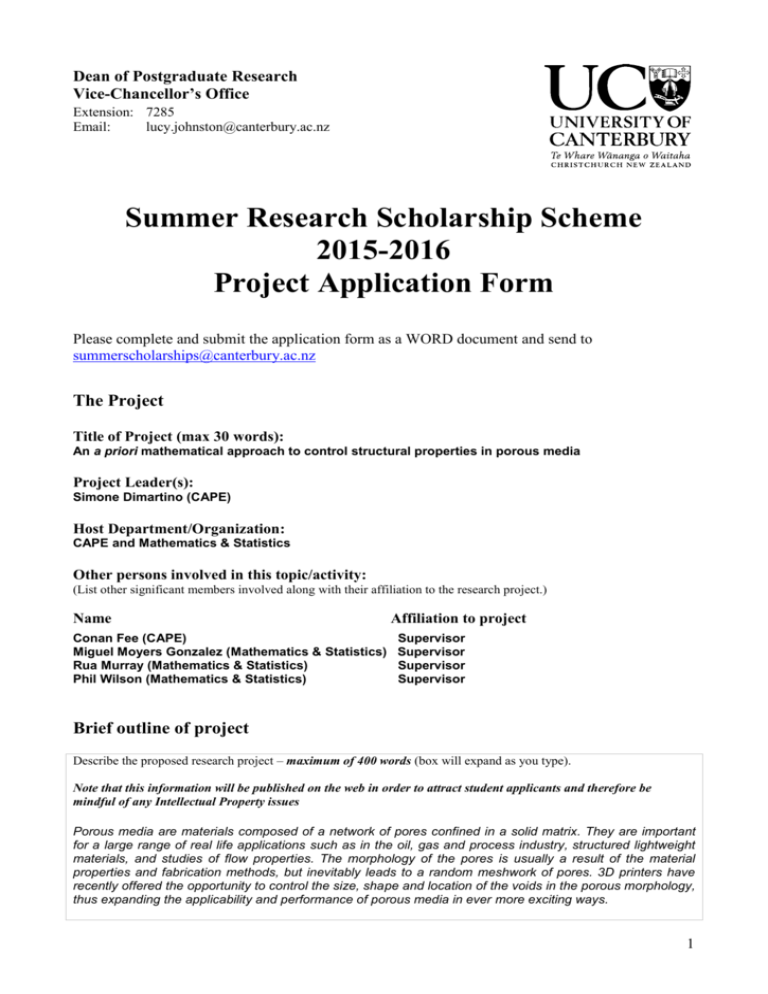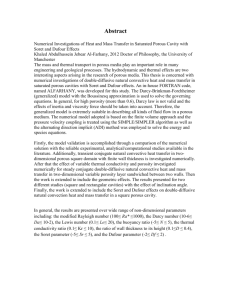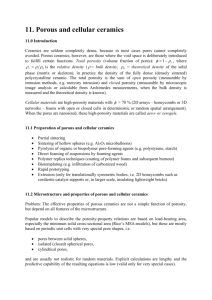An a priori mathematical approach to control structural properties in
advertisement

Dean of Postgraduate Research Vice-Chancellor’s Office Extension: 7285 Email: lucy.johnston@canterbury.ac.nz Summer Research Scholarship Scheme 2015-2016 Project Application Form Please complete and submit the application form as a WORD document and send to summerscholarships@canterbury.ac.nz The Project Title of Project (max 30 words): An a priori mathematical approach to control structural properties in porous media Project Leader(s): Simone Dimartino (CAPE) Host Department/Organization: CAPE and Mathematics & Statistics Other persons involved in this topic/activity: (List other significant members involved along with their affiliation to the research project.) Name Conan Fee (CAPE) Miguel Moyers Gonzalez (Mathematics & Statistics) Rua Murray (Mathematics & Statistics) Phil Wilson (Mathematics & Statistics) Affiliation to project Supervisor Supervisor Supervisor Supervisor Brief outline of project Describe the proposed research project – maximum of 400 words (box will expand as you type). Note that this information will be published on the web in order to attract student applicants and therefore be mindful of any Intellectual Property issues Porous media are materials composed of a network of pores confined in a solid matrix. They are important for a large range of real life applications such as in the oil, gas and process industry, structured lightweight materials, and studies of flow properties. The morphology of the pores is usually a result of the material properties and fabrication methods, but inevitably leads to a random meshwork of pores. 3D printers have recently offered the opportunity to control the size, shape and location of the voids in the porous morphology, thus expanding the applicability and performance of porous media in ever more exciting ways. 1 The goal of this project is to develop a systematic approach to the different geometrical morphologies that can be theoretically designed in porous media. We have already identified some interesting geometrical morphologies. The successful student will start from these preliminary geometries and build up a set of geometries to expand the capability of our 3D printing approach and the applications of the resulting porous media. Specific constraints will be progressively considered, such as maximization of exposed surface area and void fraction while maintaining a good equilibrium between the size of the pores and of the solid elements to maintain structural integrity. The problem can be formulated as an optimal control problem and will be solved using MATLAB or an equivalent software. Finally, the student is expected to make recommendations on the appropriate geometries for specific applications in chemical engineering. Success of this project will lead to the improvement of the current 3D printing capability developed at UC, with possible commercialization benefits. If the project involves work away from the University campus (e.g., at fieldwork sites) please detail all locations. NA If the student be required to work outside of normal university hours (8am-5pm) please provide details NA Benefits student will gain from involvement in the project Describe the research experience and skills that the student will acquire through involvement in this research project – maximum of 100 words. The student will work in a highly interdisciplinary environment with researchers from Mathematics, Material Engineering, Chemical Engineering and Mechatronics, and will be exposed to a highly dynamic project funded by the Ministry of Business Innovation and Employment. The student will primarily improve his/her skills in generation of new porous geometries, but the real advantage is the possibility to apply theoretical considerations in a real word application with strong commercialization possibilities. Specific student requirements Please provide details of all requirements you have for the student to work on this project – for example, if specific courses/experience are necessary. The successful student needs to have excellent grades in mathematics or engineering mathematics courses, needs to be skilled in MATLAB or an equivalent, and highly motivated to work in a team. The background of the student will be in mathematics or a related discipline, preferably with interests in solid geometry. An engineering student with a strong mathematical background would also be considered. 2











